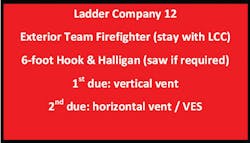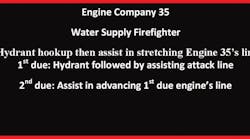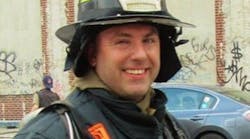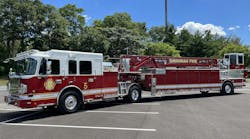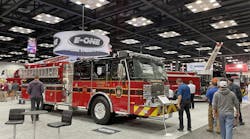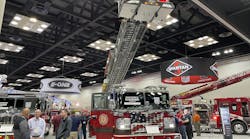Departments seeking to maximize their capabilities should consider just how effective it would be to implement riding assignments as part of their daily routine. Riding assignments are a pre-arranged format for responding personnel. Whether the department is a career organization or a volunteer fire company, the advantages of pre-arranged riding assignments offer enormous value.
The issue is this: today’s response assignments consist of a finite amount of resources and it is important that we maximize these resources. Using the concept of “Division of Labor,” we can pre-organize personnel into specific areas or specific specialties. What we will attempt to show in this series of articles is just how riding assignments can enhance a department’s speed and effectiveness and improve its command and control ability as well as organizational safety.
The Dread of Micromanaging
Have you ever been to a scene where the incident commander (IC) ends up micromanaging many individual tasks? For example, the IC tells the first-due engine to stretch a line or orders the first-due truck to force entry into the fire building, or orders the second-due engine to establish a sustained water supply and feed the first-due engine. While all of these tasks are critical, such commands on the part of the IC takes away from his or her time to size-up the building and concentrate on strategic factors and safety issues such as warning signs of flashover, backdraft, building collapse, as well as a host of other issues.
What if many of the tasks associated with the first two engine and ladder companies were pre-assigned for the most typical responses? For example, what if every first-due engine company knew it was their responsibility to establish a sustained water supply and stretch the first line to protect the greatest life hazard? Or the first two engine companies team up to assure a line is rapidly placed into operation? Or that the first-due ladder company always provides an unimpeded path to the seat of the fire?
Such a pre-assigned series of tasks would alleviate the IC from having to micromanage these more common activities. This is the benefit of riding assignments. For the more typical responses, being pre-organized allows the IC to concentrate on the larger picture. Will there be times where pre-organized plans will not apply? Of course! But for the more typical responses you participate in every day, certain common issues arise. Think about it … at the typical building fire, do you want a line stretched? Do you need a door opened? Do you need to search for victims? Do you need a water supply? Your companies can go into action instantly without the IC having to order numerous assignments.
Riding Assignments
While riding assignments are suitable for the more typical responses, they are not a cure-all for every response. Rather, they are geared towards the simple tasks that would be expected of the first-due companies at the most common incidents and responses. These assignments would be the typical actions expected unless the situation presented something unique from the norm.
Pre-arranged tasks and pre-arranged tool assignments offer exceptional flexibility to the most common incidents. For example, the actions of first-due companies to a small room and contents fire in a two-story private dwelling will generally be similar to past operations. The actions while operating at a call for a report of a smell of smoke or an alarm activation in a commercial occupancy along Main Street, USA will have similarities to responses in the past. Riding assignments allow the IC to know that certain responsibilities are already being covered or ready to be covered if so needed. This is based on past experiences and knowing what has worked successfully in the past for the more typical incidents.
With some simple plastic or metal tags engraved with pertinent information affixed next to a seat on the apparatus, members can have their memory jogged every time they climb on board (Figure 1). This works in conjunction with department pre-planning and a good training program, which will offer a level of efficiency that up to this point may have been lacking.
Riding assignments can be divided into four major elements:
- The objectives of the first-due engine and ladder companies
- Tool assignments for each firefighter
- Task assignments for each firefighter
- Tasks depending on the occupancies
Objectives of the First-Due Engine and Ladder Companies
Let’s take a look at the first of the four elements identified above: the overall objectives that you want the first- and second-due engine companies to accomplish and the objectives that you want the first- and second-due ladder companies to accomplish.
First-due engine and ladder companies – Let’s take a look at an example of riding assignments for four-person engine and ladder companies (Figures 2 and 3). These assignments have to provide a lot of room for flexibility and cannot be so specific that it becomes unrealistic. Also, riding assignments are most suited for the first couple of engine and ladder companies responding to an incident. Beyond this initial response, the IC needs the flexibility to send resources to where they are most required. Therefore, riding assignments are not realistic for personnel beyond the initial response.
First- and second-due engine companies – These positions have to be appropriate for the majority of responses that your department responds to such as reported building fires, alarm activations, smoke conditions, as well as other more common responses in, say, non-standpipe equipped buildings.
Riding assignments should spell out for each member what the engine or ladder company will do if it’s first or second due. Beyond the first- and second-due companies, there are too many “what if” questions.
At the typical building fire in a non-standpipe equipped building, such as a typical private dwelling or apartment, the roles are relatively simple, unless unforeseen circumstances or special hazards are encountered.
Some special hazards or considerations for the IC to consider would be large, open floor plans with the need for a team search using rope lines or the threat of disorientation or a large “big box” type structure with unusual fire loads and truss construction.
In the typical routine scenario, the first-due engine company may be tasked with establishing the primary water supply and stretching the initial attack line.
The second-due engine may then be responsible for augmenting the actions of the first engine, thus ensuring that a sustained water supply is available and the attack line is being moved effectively and with enough personnel.
This is just one way of accomplishing such a task. Other departments may not team up engine companies and may have them establish their own water supplies and stretch one hoseline each. Regardless, riding assignments work best when members know what is expected of each company.
The first- and second-due ladder companies – As with the engine companies, the roles assigned to the first- and second-due ladder companies have to be what works for the department. All members have to understand their role for this to be successful.
For example, let’s say that a department requires the first-due ladder company to create an unimpeded path to the seat of the fire, search for victims on the fire floor and initiate vent operations. The second-due ladder company may then be required to augment the vent operations. If the first-due truck carries out vertical venting, then the second-due truck initiates horizontal tasks such as Vent, Enter, and Search (VES), or vice versa depending on what the department thinks is most critical. In addition, the second-due truck then conducts search activities that cannot be accomplished by the first-due truck company, such as on the floor above the fire.
Regardless of what a department chooses as their primary concerns for these first four companies, all department members must know the game plan. This will save the IC the additional burden of having to give these orders when such orders can be pre-arranged. Unless something unusual occurs, the IC can plan on well-trained officers and members carrying out the basic tasks.
Part 2 of this series will explain the three remaining elements of effective riding assignments.
ARMAND F. GUZZI JR. has been a member of the fire service since 1987. He is a career fire lieutenant with the City of Long Branch, NJ, Fire Department and is the deputy director of the Monmouth County, NJ, Fire Academy where he has taught for over 20 years. He has a masters degree in management and undergraduate degrees in fire science, education, and business administration. View all of Armand's articles here. He can be reached via e-mail at [email protected] or [email protected].
